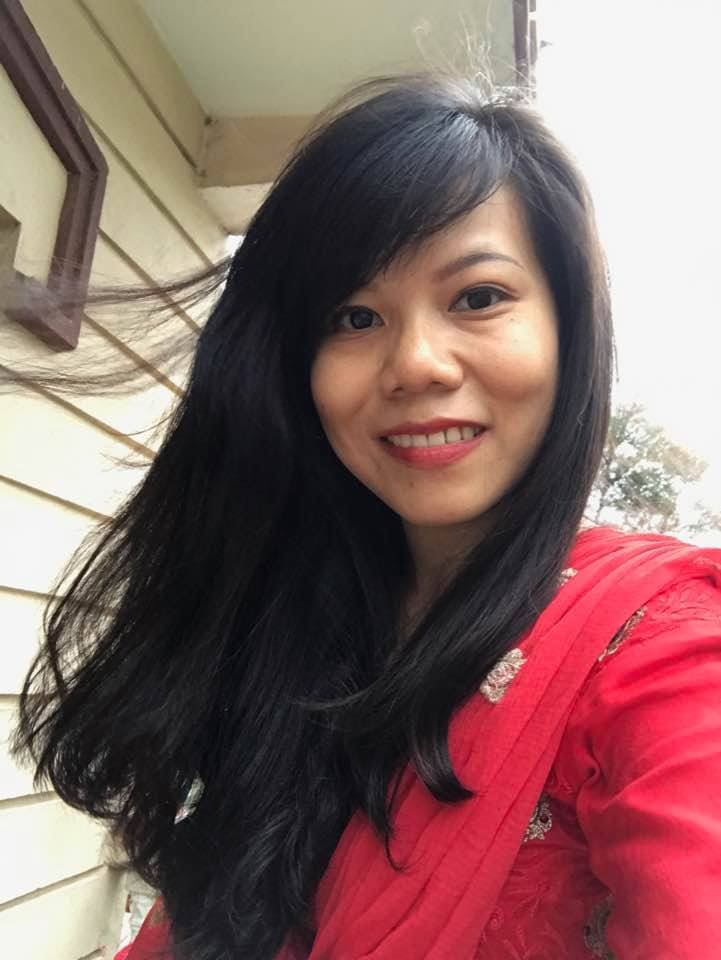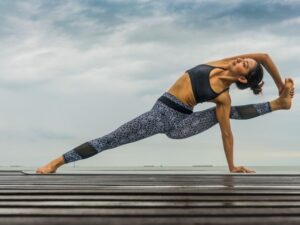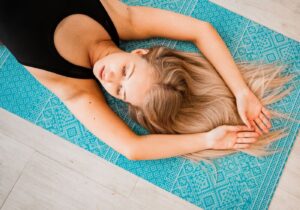The once and only essential yoga equipment for beginner is a yoga mat. And similar to another fitness style you will need comfortable breathable clothing.
When getting started with yoga, you may feel overwhelmed about which yoga gear you need for your practice. The good news is you can keep your gear to minimum without overspend on yoga equipment.
In this article, we guide you through why some gears are essential than other and quick tips on how to choose.
Keep in mind that it is important to know if want to commit to yoga long-term and which style that you want to stick to. Vinyasa yoga you may need a set of blocks, while Inyengar focuses strongly on alignment so it is common to use a lot of different props.
Essential Equipment
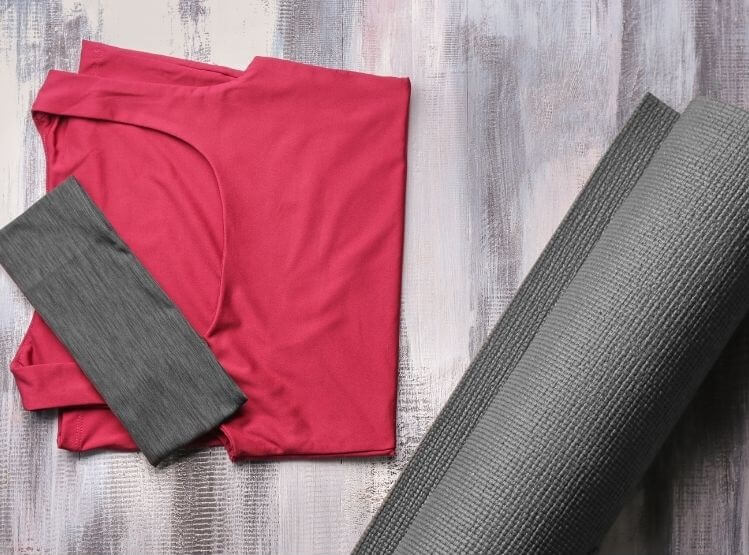
Mat
The #1 gear you need on your yoga journey is a yoga mat. A mat provides grip supports so you don’t slip on the mat when holding the pose. Also, it comes with a padding layer to support your knee in some poses.
Most studios and gyms offer mats for free or rent for a small fee. But you may feel uncomfortable with the cleanliness of the shared mat. Then you may consider buying a yoga mat of your own.
Price
You don’t need to lay out much cash on a yoga mat when you begin. A cheap mat ($10-$20) is fine. But if you commit to yoga, you find that you want to replace it. Then invest in a premium mat ($80-$150) which makes a huge difference for your practice.
Quick tips on how to choose a yoga mat.
Mat comes with different material, thickness, weight, length… But don’t stress out! There are 3 main things to consider when choosing your yoga mat:
- Sticky enough to stay safe with your practice. But not too sticky so you can learn how to engage your core to grip.
- Thick enough for cushioning your knees. (Especially if you have sensitive knee.)
- Material that makes you feel good to lay down on or put your chest against.
Next, check out where you want to use your yoga mat. Practice at home you don’t need to care about the weight (only when you have a car). If you want to carry your yoga mat daily look for a lightweight option. Or in between if you want to buy one yoga mat for all usage.
If you like to practice sweaty Power yoga consider the stickiness, if you like relaxing Yin yoga consider thickness. If you are eco-conscious find natural rubber or recycle material.
With just a few clicks you can buy a yoga mat online. But it always better to get advice from your yoga teachers or test out at the shop before purchasing. (Down-dog to test thed grip, Low Lunge Twist with Knee bend to test the cushioning.)
Here is detail guide on how to choose a yoga mat.
Clothing
As you are new to yoga, it is enough to use your exercise clothing. Find clothe which is comfortable, moisture-wicking fabric, and form-fitting.
And when you want to commit to yoga practice. You can spend more money on trendy yoga apparel.
Pants or Shorts
- Choose stretchy pants or compression shorts. Make sure it stays while you do inversion pose. The dark color of pants/shorts which easier to mix-match with different tops.
- Shorts are more popular among men yogi, but also for women if the room is hot.
- Running short is fine too but make sure it has connecting tight to prevent overexposure during your practice.
Tops
- Choose form-fitting tops so it does not fly over your head in some pose. Do bend over test to check it stay in place.
- Keep a long-sleeve shirt or hoodie for relaxing savasana when it gets chilly.
Sport Bras
- For women, sports bras help you feel comfortable and minimize your breast movement when you transit between poses.
Hair Ties or Headband
- If you have long hair, use ties or headband to secure it in place.
Extra Equipment
If you go to a yoga class you don’t need much extra gear. But if you do yoga at home a set of blocks and a yoga strap is helpful to keep your alignment while posing. Fan of relaxing yoga style like Yin or Restorative prefer to have a bolster and a blanket to get better support.
Keep reading to find out if you need extra gear for your practice.
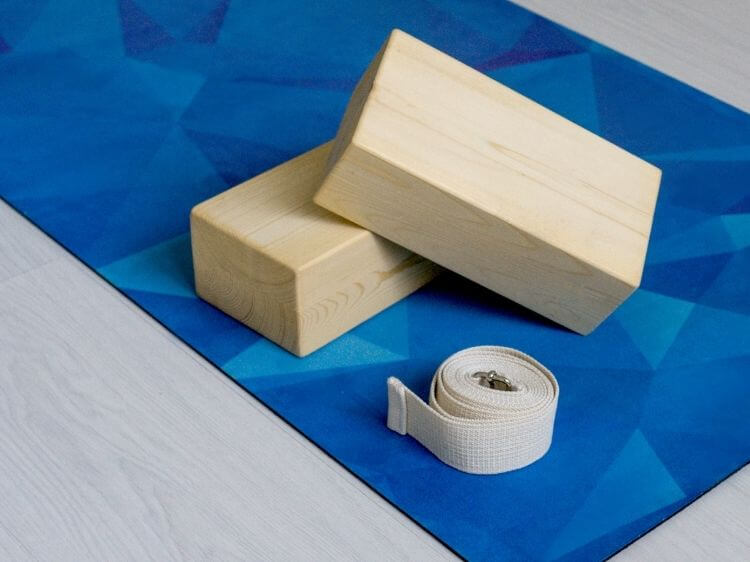
Blocks
Why use yoga blocks?
Blocks are key for pose modification. It assists you to maintain proper alignment, stabilize your position, and help you feel the pose where it is supposed to be felt. Here are few usages of block:
Stay balanced in standing pose:
- If you go down to Triangle pose/Revolved Triangle/Half-moon and you can’t reach your hand on the floor, you get out of the form. Put one hand on the block to lift your torso then find the stretch and maintain your balance.
Support in stretch
- In bridge pose place the block under your hip to release pressure for the lower back.
- Pigeon pose if sitting bone far off the mat you may feel uncomfortable. Place a block under your front leg to rest and straight your spine.
Core work
- Put the block between your legs in boat or bridge pose to get your muscle to work.
Do you really need a yoga block?
If you practice yoga at home, you may need a set of yoga blocks. (At the beginning many use a thick book instead of a block but overtime block is quite useful.)
Tips on how to choose yoga block
Blocks are made out of foam, wood, or cork and have 3 different heights. You can change direction depending on pose. When it comes to choose a block, material is an important factor.
- Foam: Provide more cushion, light-weight, affordable, less stable.
- Wood: Look nice, not gently feel, heavy
- Cork: In between Foam and Wood
Recommend to buy a set of two.
Strap
Why use a yoga strap?
Yoga strap acts as arm extension to improve flexibility and keep proper alignment when you have tight muscles. Strap helps you to deepen your stretch, twist, increase your flexibility over time.
Here are few ideas on how to use a yoga strap:
Bring hand closer to your feet:
- For hamstring stretching: Seated forward fold, you can put a strap around your feet and hold the strap to keep your spine long.
- For Heart opening stretching: King dancer pose, king pigeon pose. Put the strap around your feet, then bring your hand to the strap, kick your foot and slowly reach your hand toward your toes.
Binding your hand in twist
- In Cow face pose. Grap the strap with the top arm and connect with the bottom arm behind your back.
Stability for arm balance
- Create a loop and wrap around your both upper arm to keep your elbows to stay aligned with your shoulder.
Yoga strap alternative? Around the house, you can use a belt or scarf to replace straps. Or if you have a yoga mat strap you can use it too. But in some cases it is too short then get yourself a strap.
How to choose a yoga strap?
Choose a strap that is long enough for you (1.8 meters) easy to make a loop. With both plastic and Metal D ring buckle you can adjust the length of the loop, Metal D ring can make a little bit of sound.
Bolster
Bolster is mainly used to support you in relaxation yoga style like Yin & Restorative yoga.
- Place the bolster under your upper back to do a gentle chest opening when you lie down. (Reclined Butterfly Pose)
- Make sit comfortable in Hero Pose/ Reclined Hero Pose by placing the bolster under your hip.
- Lay your head on the bolster in Wide-Angle Seated Forward Bend.
Bolster has two shapes round and rectangular. Rectangle shape useful in a lot more poses while the round shape gives support in some stretching & heart-opening.
Blanket
Two main usages of yoga blanket: provide padding support and cover your body.
- Fold your blanket, put it under your knee or hip for comfortable and relaxing pose.
- Roll blanket and use like a bolster. Put it under your neck, or your back when lying down.
- Cover in savasana when the room gets chill during your practice.
While Yoga blankets come in many style and materials, the Traditional Mexican blanket is quite common.
Wheel
Yoga wheel starts to gain popularity in yoga studio but as a beginner, you may not need a wheel.
How to use yoga wheel:
- Put yoga wheel under your back to do spine massage and open your heart.
- Do hamstring stretch and strengthen your core at the same time. Put one leg on the wheel and slowly rolling the wheel further to get stretching.
- Support in forearm stands by grasping both hands with the wheel.
If you want to buy a wheel, look for one that has a good cushion.
Mat carrier
To carry your rolled yoga mat around you need a mat carrier. There are two common styles is yoga mat bag and yoga mat strap. I prefer strap-style for a short distance while the bag is better if to go long way.
Water Bottle
Water Bottle is not necessary if you a home-yogi. But if you join a studio class, a water bottle keeps you stay hydrated during the class.
If you can buy a bottle that can keep your water temperature in case you practice outdoor.
Hand Towel
Hand towel to wipe your face during yoga workout to prevent sweat get into your eyes or wet your mat. Especially if you like sweaty flow like Vinyasa or Power yoga.
Choose a hand towel that is big enough (40cm by 72 cm) size. So you can use it as a strap or place it under your knee for cushioning.
Yoga Mat Towel
Many yogis love yoga mat towels. A good layer to prevent slippery from the sweat drop out while doing yoga or to rest on without smelling rubber. And can throw in the washing machine for cleaning.
Make sure that the size is big enough to cover your mat.
Summarize (Yoga equipment list)
What do I need to bring to a yoga class?
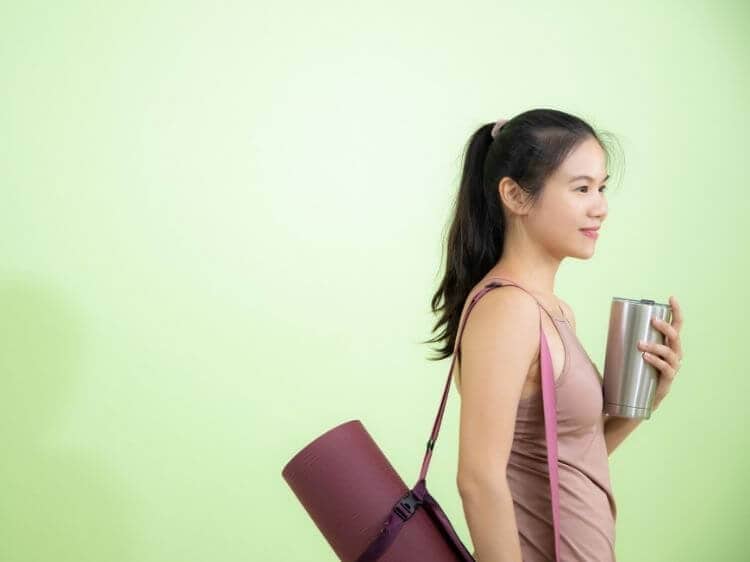
The yoga equipment list is long. To sum up, here are most useful gear to bring to your yoga class below.
- Yoga clothing
- Water bottle
- Hand Towel
- Your yoga mat + carrier or yoga mat towel
What equipment do I need for a home practice?
You may need below 3 equipment for yoga at home for most of your practice:
- Mat
- Blocks
- Strap
Frequently do Yin and Restorative yoga you will love these
- Bolster
- Blanket
And when you want extra for core & advanced practice
- Wheel
What’s next?
I hope this article provides your question on essential equipment that every beginner should have at home.
You can also read our next article which helps answer the question “How do I get started with Yoga at home?” This will help give you more information on how to create and maintain a healthy lifestyle that includes both exercise and relaxation. Happy stretching!


